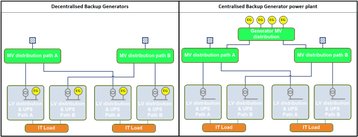In a previous post regarding our new data center reference design 107, I explained the design choices and key factors that resulted in a highly cost optimized electrical distribution network. This blog will focus on optimizing the backup generator power plant and the way to connect them on the electrical architecture.
Since generators represent a significant portion of data center infrastructure cost, especially for the colocation segment, this a key subsystem to optimize. Today, in the context of large, hyperscale data centers, we are mainly considering and comparing two types of architectures:
- Decentralized backup generator power plant using one generator per MV/LV transformer regardless of the redundancy level
- Centralized MV backup generator power plant for the overall site with N+1 or N+2 generator redundancy
Let’s now compare the main factors to decide what is the best approach according to the specific constraints and requirements.
Optimizing generator cost
Of course, the key driver for selecting generators and how to optimize this part of the infrastructure is cost. There are several things to consider:
Generator size
- Using one genset per power train obliges us to match the power between the transformers and generators, there is no flexibility.
- Using a centralized generator plant allows us to choose a generator size that is most cost-effective (the best €/W in terms of CAPEX and OPEX) and with the best procurement lead-time.
Redundancy and number of generators
- By definition, with one genset per power train, the amount of redundancy at the power train level dictates the generator redundancy be the same. Basically, if the LV distribution is at 2N, you will need the genset to be at 2N as well.
- One of the main advantages of the centralize generator power plant is being able to use N+1 or N+2 generators, regardless of the architecture downstream. That gives a lot of flexibility in the design and allows you to optimize the number of generators to be installed. (Note: As explained in our white paper 262 generally N+1 generators can be enough – up to 6 to 8 generators – but beyond that, N+2 would be required to achieve a high availability).
Growth plan/scalability
- With genset placed at each power train (in the case of the decentralized power plant architecture), each time you install a power train, you will need to install its generator, sized for the maximum expected load in the worst-case scenario. So, in this architecture, the generators are installed as the data center infrastructure grows.
- With the centralized generator power plant, of course, it is also necessary to size the generators for the worst-case scenario. However, it is possible to adapt the number of generators knowing the real load of the existing part of the data center. For example, if the real load consumption is 40 percent of the expected load on the existing IT rooms (lower rack density, for example), you can consider that situation in the calculation of the additional requested backup power and maybe delay the generator investment until the new IT room is installed.
Impact on the MV distribution
When the generators are decentralized with each associated to a specific MV/LV transformer, the upstream MV distribution is not critical to the uptime of the load because in the event of a failure on the MV distribution, the load will still be supplied by the generator “locally.”
When the generators are centralized at the MV level, all of the electrical distribution downstream becomes critical for maintaining uptime of the load. In most cases, especially for colocation data centers, having a fault tolerant system is required making the MV distribution more expensive and requiring a more complex MV protection and control system. This is clearly the main disadvantage of the centralized power plant architecture. It also requires more advanced engineering competencies to pull this off in practice. (Again, to learn more about N+1 MV generator power plant architectures, refer to white paper 262).
Of course, the complexity of the MV protection and control system will bring more commissioning time during the first phase of the data center because it’s needed to be put in place for the overall system at the MV level. Even if the architectures are scalable and modularized to reduce the commissioning time, the first phase requires testing the entire power plant control system. But for future build-out phases it also means there is no control system at the power train level and that will simplify the commissioning at the power train level, at least.
How to choose the right architecture
For large hyperscale data centers, the main advantage of the centralized MV generator plant is the cost optimization of the genset, given the flexibility in the choice of the power rating and in the number of generators used, regardless of the size and redundancy level of the power train. That also allows adapting the generator growth plan to the real needs of the data center. In case of a heterogenous load not fully known during the design phase, this flexibility can be a key advantage.
However, in the case of homogeneous loads with a high rate of power consumption and when already using a power train redundancy of 4+1 or beyond (i.e., distributed redundant or block redundant architecture) the generator cost savings will probably not be enough to justify using more the complex system like centralized backup power plant.
We wanted to propose a very flexible architecture in reference design 107 because it was geared towards colocation applications. That’s the reason why we chose to use a centralized backup power plant using closed ring distribution in order to have a fault-tolerant system with a very high level of reliability. Access the reference design now to see whether it can meet the flexible architecture and cost requirements for your colocation facility.





